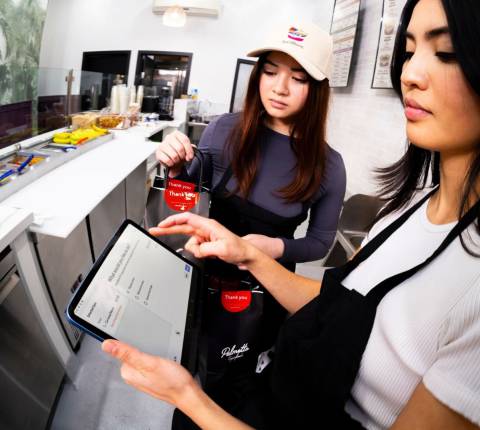While food sales are the chief source of revenue for most restaurants, beverage sales make up an important portion of overall profits. You may sell more food dishes than drinks, but the high profit margins on alcohol mean your liquor costs can make or break your overall profitability.
Whether you operate a restaurant or bar, understanding your liquor cost percentage will help you improve your overall profit margin. Here, we'll explore what a liquor cost percentage is, how to find your liquor cost percentage, and tips for optimizing it to maximize profits.
What is a liquor cost percentage and a beverage cost percentage?
Liquor cost percentage is the ratio of what it costs to make a drink compared to the drink's retail price. Also referred to as the beverage cost percentage — or more simply, the pour cost — it's a key metric that every bar and restaurant manager should track in order to understand your profitability.
Beyond the alcohol itself, direct beverage costs include money spent on mixers, garnishes, and anything else required to make and sell drinks.
What should your beverage cost be?
You might be asking yourself: What is a good liquor cost percentage? Generally, most bars and restaurants should strive for a pour cost between 18% and 24%. The average bar has a pour cost of 20%, indicating that every dollar of beverage sales generated costs the business 20 cents.
That said, the average pour cost varies for different types of alcohol — roughly 15% for liquor, 20% for draft beer, 25% for bottled beer, and between 30% and 40% for wine. That means if you run a wine bar, your liquor cost percentage will likely be higher (and profits lower) than a bar that focuses on cocktails. Be sure to review the individual components of your beverage program to understand the liquor cost percentage for each type of alcohol or drink menu item you sell.
These figures provide a helpful benchmark for business owners to understand how their beverage pricing stacks up. If your pour costs tend to be higher than industry averages, it signals that there may be room for improvement. Periodically analyzing your menu and adjusting prices and promotions is also a smart way to optimize your liquor strategy.

Every six months we'll double-check our profits and then start going through to see what's selling, what's not selling. Whatever's really popular, we'll go through and make sure that that profit makes sense.
How to calculate liquor cost percentage
To manage business profitability, bar and restaurant operators should regularly review their pour costs. Aim to calculate your beverage cost percentage on a monthly or even weekly basis to monitor for and prevent serious issues like theft, as well as identify sales trends, optimize your drink menu, and test new pricing strategies as needed. This is one business metric you have control over, so take advantage of the information available.
To manage profits of your overall beer, liquor, wine, and even non-alcoholic beverage sales, use the liquor cost percentage formula — which simply takes your total beverage cost of goods sold (COGS) and divides that by your beverage sales over a certain period of time.
Total Liquor Cost Percentage = Total Cost of Goods Sold / Total Alcohol Sales x 100
For example, if your bar sold $5,000 worth of alcohol, which generated $25,000 in sales over a specific time period, then your liquor cost percentage is 20%.
5,000 / 25,000 = .2 or 20%
Because not all alcoholic beverages are sold in their individual bottles or containers (i.e., you may serve customers a bottle of wine, but not a bottle of vodka), you can calculate the cost per ounce for each alcohol type to help you accurately price drinks.
Liquor Cost Per Ounce = (Container Cost / Ounces Per Container)
There are additional formulas to account for inventory not sold and individual drinks. That said, most operators opt to use their POS or inventory management software to determine their liquor cost percentage, rather than do the math manually.

How to lower your liquor cost percentage
A high pour cost can be caused by a number of factors, such as overpouring, frequent spillage, unrecorded comps, and theft. Beyond adjusting menu prices, here are some steps your business can take to lower your liquor cost percentage and take control of your beverage profits.
1. Track weekly inventory
Inventory management entails knowing exactly which products and how much of each you currently have in stock. Performing routine inventory on your restaurant's liquor, wine, and beer supplies will reveal what moves quickly and what doesn't, providing powerful insights for menu planning. It can also point out any discrepancies and potential product loss that can result from over-pouring or spillage.
2. Prevent theft
Theft can be an issue for all small businesses, internally and externally. But in the food service industry, theft can also mean undercharging, falsely voiding a check, and comping drinks. Aside from hiring reliable and trustworthy people, operators can monitor bartenders' tabs and cash reserves, communicate the consequences of theft on both your business and their employment, and keep a comp sheet to track the number and cost of complimentary drinks each shift.
3. Reduce waste
The cost of mistakes can quickly add up. Encourage staff to ring up all returned drinks, double orders, and spills in the POS — if it's significantly eating into your profits, set aside time for more training. Beverages can also be lost to improper storage, so understand how to maximize the shelf life of your beer, wine, and spirits.
4. Standardize cocktail recipes
It's no secret that creative cocktails have become the hallmark of bartenders across the world, but the cost of extra ingredients adds up quickly and can negatively impact profit margins. Create a pour policy that sets clear standards for the number of ingredients used in each cocktail, as well as the size of the pour for wine, beer, and single, unmixed liquor drinks. You can also encourage or require the use of measuring tools like pouring spouts and jiggers to ensure precision.
5. Train your staff
Overpouring may seem harmless, but it can cost your business significantly in the long run. Implement an effective training program to ensure staff not only have the experience needed to work behind a bar, but are also prepared for stressful circumstances like making multiple drinks at a time. Even during the busiest shifts, they should strive for quality and consistency as well as speed.
6. Switch to lower-cost suppliers
You can also add to your bottom line by negotiating better prices with your beverage suppliers — perhaps by buying in bulk or reducing packaging costs. Consider building relationships with local producers who may be able to work with you on a mutually beneficial partnership.
7. Introduce seasonal beverages
Consider offering crowd-favorite seasonal cocktails like hot toddies in the winter or sangria in the summer. Anything easy to prepare in large amounts in advance will translate into higher profit margins and efficiencies. Customers also appreciate seasonal, fresh items and may be more willing to pay premium prices for them.
The advantages of alcohol delivery
Another way to boost profitability is by offering alcoholic beverages on your delivery menu. This will help you appeal to new customers and gain visibility, as your business will be included in DoorDash's dedicated alcohol delivery section.

If you’re considering signing up for convenience and alcohol delivery with DoorDash, do it. DoorDash brings you new customers from outside your regulars, and it’s extra revenue for your business. It’s allowed us to invest in a new refrigeration unit to help keep our delivery orders cold.
Pour more profits into your business
Calculating your liquor cost percentage is simple as long as you maintain diligent sales and inventory records and keep your POS up to date. By regularly monitoring your pour cost, you'll be able to test different pricing strategies and cocktail recipes to optimize profits at your restaurant or bar.
Explore food pricing in greater detail as you devise new ways to boost the profitability of your business — and to help drive your beverage sales even more, sign up for alcohol delivery with DoorDash.





